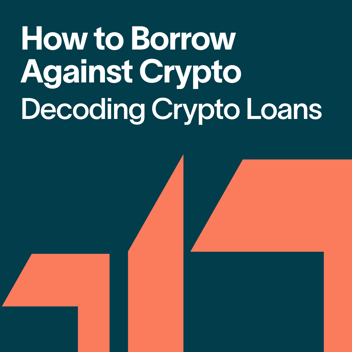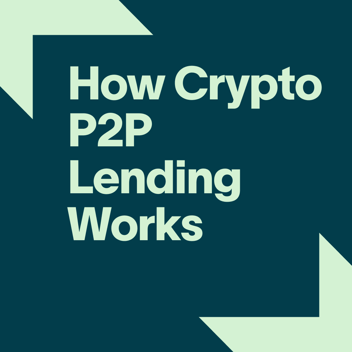The Differences Between Crypto Staking & Crypto Lending: Which is Right for You?
.png?width=1600&height=900&name=The%20Differences%20Between%20Crypto%20Staking%20%26%20Crypto%20Lending_%20(1).png)
When it comes to traditional finance, one of the primary methods of earning additional money is to lend it out. However, in the crypto space, there is a major alternative to this, known as staking. This is a deeply fascinating idea, and one that many people have made a lot of returns from, but typically, it is more complex, and there is a steeper learning curve. Let’s unravel this, and discover the differences between crypto lending vs staking.
What is Crypto Staking?
Crypto staking is where somebody chooses to lock away a certain amount of an asset onto a blockchain for a set period of time, with them receiving financial rewards for doing so. This can be done on any proof-of-stake blockchain, where you would lock away assets that are native to that chain. For example, people can stake ETH on the Ethereum blockchain, or TRX on the TRON chain.
By locking these funds away, you are helping the blockchain stay operational, as your staked assets contribute to the network, ensuring transactions are validated and added to the blockchain in a secure and trustworthy manner. By entrusting the blockchain with your assets, you are signaling your confidence in the network's integrity and future, and supporting the ongoing growth and security of the digital ecosystem. As a result of doing this, the network rewards you with additional digital assets. In this sense, it can act as an alternative to a crypto savings account, as it can help grow your digital assets in a relatively passive way.
How Does Crypto Staking Work?
Typically, when you stake crypto, you are choosing to enter a certain amount of digital assets into a wallet, and then having those assets held by the network for a period of time. During that time, you cannot access your assets, however afterward, it is released to you and back in your control. Generally speaking, the more assets you stake, and the longer you lock it away for, the more you are rewarded at the end of the period.
Related Content: Does your crypto grow in a wallet?
Technically, the assets are still in your control, even when you stake it, in the sense that you maintain ownership of the keys to the address. However, the nature of staking means that you cannot simply choose to unlock it until the time is up. This means that the action is largely self-custodial, but with the caveat that, even if nobody else is looking after your money during this period, you cannot move it.
What is Crypto Lending?
Crypto lending is the process of choosing to lend your digital assets to somebody else, with the intention of earning interest from the borrower. Some services allow you to directly lend your assets out. However, many companies, such as Ledn, handle all the lending and interest for you, via their easy-to-use Growth Accounts.
How Does Crypto Lending Work?
Crypto lending is where you let other people borrow your digital assets, with them returning the money after a set period of time. Those that borrow crypto pay a premium for this, in the form of interest. For Ledn’s Growth Accounts, this happens somewhat automatically, with them pooling together the assets that are held in such accounts, and then using those assets to lend out to other borrowers. A portion of the interest these borrowers pay to Ledn on this is then provided to the Growth account holders, allowing for a type of passive income.
Related Content: Best Crypto Interest Rates in 2024
The Difference Between Crypto Lending vs Staking
Let’s delve further into this topic of crypto lending vs staking. These are two very different avenues of earning passive income, both working in different ways, and offering separate utilities.
The Pros and Cons Of Staking and Lending Crypto
To begin, we should take a look at the strengths and weaknesses of crypto lending vs staking. This will give us a better indication of the two avenues.

The Pros Of Lending Crypto
Crypto lending is a highly popular method of growing wealth, whilst also adding to the wider crypto community. For many people, it is a fantastic way of earning in a low-maintenance way.
- Similar to traditional lending: earning interest via crypto lending is very similar to how traditional lending works. This is especially the case when working with a centralized service like Ledn. This is a big perk as it means there is a reduced learning curve. All you need to do is place your digital assets into a dedicated Ledn account, and you will earn interest daily, which is paid at the end of each month.
- More flexibility: By using savings or growth accounts, you’re able to lend on an open term. This means you start earning interest immediately and can withdraw anytime. For staking, your crypto is locked away for a fixed period of time.
- Earn interest on Bitcoin: You cannot stake Bitcoin, as it is not a proof-of-stake asset. This means that no staking service can offer you interest or passive income. However, you can always choose to gain interest via lending Bitcoin.
- Good customer service is available: If you choose a centralized lending provider, then you get access to customer service representatives, should you ever need them. This is a huge benefit when it comes to crypto lending vs staking, as all staking services are decentralized, and so getting help from other humans is rarely possible.
- Working with a reputable company offers greater safety: If you choose a lending provider with a good track record, and who is transparent about their financial activity, then you can find yourself in safe hands. This is great, as it means you do not need to worry about your digital assets disappearing or the company collapsing and becoming insolvent. Of course, for this level of safety, you must choose a service that is known to be trustworthy.
The Cons Of Lending Crypto
Now let’s take a look at the potential negatives that come with crypto lending, to help frame this discussion.
- Different assets have different interest rates: Some assets might not offer you much interest if you lend them out. This will be dependent on how much demand there is for that asset, and how long you are willing to lend the assets out for.
- Many altcoins cannot be lent on centralized services: Centralized lending providers often prioritize more popular cryptocurrencies, such as Bitcoin, Ethereum, and USDC. However, they tend to neglect some much smaller altcoins.
- Returns can be slow: Depending on the amount you wish to lend out, and the time you set, the returns you make can be slow and steady. This is not necessarily a bad thing, as slow growth is still growth, but it does mean that crypto lending is not going to make you rich over a short space of time. It works best as a long-term commitment.
The Pros Of Staking Crypto
Let’s now take a look at the pros of staking crypto. This is a relatively new method of earning passive income, in terms of financial history, so there are many quirks to explore. Some of which offer huge benefits to end users.
- Technically self-custodial: While you do not have the ability to unlock your staked assets, you always keep access to the address that they belong to, meaning you never hand the keys over to anybody. Of course, the fact that you cannot actually use those funds until the end of the period means that there are still stipulations to keep in mind.
- Supports the blockchain industry: By being a staker, you become one of the most important participants of the blockchain industry. You are helping to keep proof-of-stake blockchains running afloat and ensuring that people’s transactions are being handled. You are integral to the project.
- You get voting rights: For some blockchains, stakers get voting rights. This means they can vote on certain matters regarding the nature and structure of the blockchain project in question. If you are somebody who enjoys being able to shape the way a blockchain gets developed in the future, then this is a fantastic perk.
- Good return rates: Some networks offer highly competitive return rates, sometimes referred to as yield rates. For instance, staking on Avalanche can yield 7.92% APY, and staking on Polkadot can even bring 14.3% APY. It can be hard to find such good numbers.
The Cons of Staking Crypto
Let’s now take a look at the cons of staking crypto.
- You place your faith in the architecture: Staking is a decentralized process. While some centralized platforms offer it as a service, they are typically acting as an intermediary for its decentralized elements. This means that you must place a lot of trust and faith in the underlying blockchain architecture. If the blockchain you use to stake on collapses or is vulnerable to hacks, then you could lose your digital assets.
- Your crypto is locked up: There is no protocol for withdrawing digital assets early. If a disaster strikes, and you need your assets early, there is nothing you can do. The assets will be locked away until the end of the period, and nobody will be able to alter the smart contract that corresponds to it.
- Long wait times: As the popularity of staking increases, wait times to be set up have increased dramatically. Data shows that wait times can be as long as 26 days.
- The price of your crypto could drop dramatically: If your asset’s value drops significantly, you can do nothing but simply watch from the sidelines, as you cannot access them early.
The Risks Of Crypto Lending
The collapse of several crypto lenders in 2022, highlights that crypto lending does come with risks.
- Risk of insolvency: If you use a centralized crypto lending provider this means that your digital assets are looked after by somebody other than yourself. During these times, your assets are largely at the mercy of the lending provider themselves. If the company becomes insolvent, or declares bankruptcy, then you could lose your assets. A recent example of this happening is with BlockFi. The best way to avoid this issue is to find a lending provider who has a strong reputation, and acts with transparency. In the case of Ledn Growth Accounts, these accounts are actually ring-fenced so that you only are exposed to the counterparties that generate your yield, meaning they are isolated from the risks of other Ledn products and services. This effectively removes any Ledn insolvency risk!
The Risks Of Staking Crypto
Of course, crypto staking also comes with some inherent risks. Let’s delve into those.
- A poorly built blockchain could be exploited: If you choose to stake your crypto on a blockchain that is unstable, then you could find your assets get stolen. Or, the network could become faulty and collapse.
- Your staking rewards could be changed by voting: Many elements of a blockchain are susceptible to changes. While these changes are often democratic in nature, and stakers often get voting rights, there are still scenarios where people may vote to reduce rewards for such activity. If this happens, then you would need to recalculate what earnings you could get. However, you would not be able to release your digital assets and access it during this process.
- You could lose your keys: Staking is a self-custodial process, and therefore you are in control of your crypto address. If disaster strikes and you lose your private keys to your address, then your digital assets will be irretrievable.
How Much Can You Make Staking or Lending Your Crypto?
When looking at crypto lending vs staking, you should consider how much you can make doing one over the other. However, working this out is not easy, and many services provide different results. Interest from staking varies by a massive degree, as different blockchains deal with staking in a myriad of ways. To work this out, you should choose a proof-of-stake asset that you are interested in, and then discover how the staking policy works for that asset.
Try to find the official documentation for these assets, and look into staking methods that involve the least intermediaries. It may be a little hard to set up staking without an intermediary, but your earnings will be higher because you will not be paying another organization to perform the administrative efforts.
When it comes to crypto lending, it can be easier to find out how much you earn. Most providers include a calculator that lets you work out your expected interest rate when you input how much you want to lend, and for how long. This is something that Ledn provides on its website. Currently, for their Bitcoin Growth Accounts, you can earn up to 1.00% APY, and for their USDC accounts, you can earn up to 9.00% APY.
Should You Consider Staking or Lending Your Crypto?
Weighing up whether you should go with crypto lending vs staking is not an easy task. Both offer promising methods of earning passive income, but in very different ways; suited to very different people. If you are somebody who works with a lot of altcoins and assets that run on proof-of-stake blockchains, then staking might make the most sense to you. Plus, by staking, you can become an integral part of the crypto ecosystem, with your money going towards helping others have their transactions accounted for and added to the blockchain.
However, if you are somebody who prefers to work with Bitcoin and other assets that are not proof-of-stake, then lending might be the way to go. Considering how BTC is still the dominant coin in this industry, it often makes sense for people to choose lending over staking. Plus, if you would prefer to work with a centralized service that is trustworthy, for the sake of good customer service and peace of mind, then some centralized lending providers can offer this.
Ledn Growth Accounts
If you want to earn money on your assets, then make sure to check out Ledn’s Growth Accounts. These are specialized savings accounts where you can earn interest on the digital assets you place in them. With just a few clicks, you can earn interest on your Bitcoin and USDC. These accounts have been created with the intention of both keeping your assets safe, whilst also helping you grow your wealth in a hands-off way (as opposed to trying to make money via trading).
With Ledn, users are fully informed about how their interest is generated. Not only this, but Ledn’s Growth account assets are only exposed to the specific counterparties that generate the yield for such accounts, rather than being exposed to other parties or the risks of other Lend products and services. This eliminates the insolvency risk discussed earlier in this blog. Users have more control over their funds than when they stake. Clients can transfer their assets between interest-earning Ledn’s Growth accounts and Ledn’s no-interest earning Transaction accounts at any time. This makes things like adding more funds or withdrawing significantly easier than staking.
In other words, Ledn’s Growth Account is about more than simply earning– it is about giving you control over when and how you earn a return on your assets. As a mark of respect and good business ethics, Ledn is open and transparent about how yield is generated, and they publish our proof-of-reserves, along with explanations on how the funds they have are used. This is found in Ledn’s “Open Book” reports. These help to form a level of trust and respect between Ledn and its clients.
Conclusion
Crypto lending vs staking is a big debate, and one without any definitive answer. In truth, both options are viable for a wide array of people. To decide which is best for you, it helps to think about what assets you own, and what type of service feels the most comfortable to you. Do you want to be a part of the cutting-edge blockchain revolution and choose to stake your assets? Or, do you want to take a more trusted route and lend your assets, where you can access customer services?
If you do decide that lending is the way forward for you, then make sure to check out Ledn’s Growth Accounts, as these are perfect for people who want to earn interest whilst having their digital assets in a setting with improved safeguards, and managed by a transparent and highly skilled team of individuals.
Sponsored by 21 Technologies Inc. and its affiliates (“Ledn”). All reviews and opinions expressed are based on my personal views.




